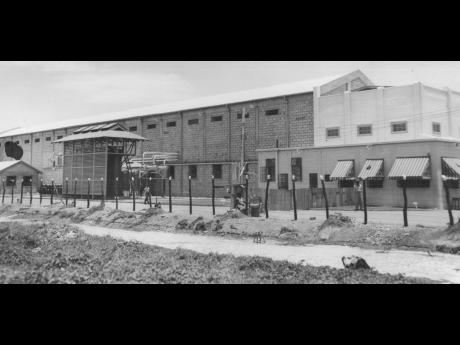Arnold Bertram | Revisiting history of industrial development in Jamaica - Part One
The level of industrialisation is an important indicator of a country’s stage of development. An evaluation of Jamaica’s industrial development and the attempt to industrialise is critical to the present discussion on Jamaica’s development agenda. As the old adage reminds, “We drive better using our rear-view mirror”.
PLANTATION SLAVERY
Jamaica’s earliest manufacturing processes, the making of sugar and the distillation of rum, were among the most advanced technological processes in the world at that time. The only other manufacturing enterprises encouraged in this period were those required to service the sugar estates and the needs of the planter/merchant class. These included foundries, the manufacturing of boots, harnesses, carriage tops and furniture.
Technological innovation was actively encouraged to improve the efficiency of the horizontal three-roller mill, the single most important machine in the sugar factory. “Between 1760 and 1830, the Assembly enacted 49 Private Enabling Acts vesting in … patentees exclusive rights to their inventions … thirty-four of which were for innovations in the sugar cane mills.”
The importation of 51 steam engines, between 1803 and 1833, to power sugar cane mills, instead of wind and cattle, was an even more far-reaching technological contribution to the making of a more efficient sugar industry. These technological advances together with the technical capacity of the 17,000 artisans comprised of blacksmiths, wheelwrights, carpenters, coppersmiths and engineers, made Jamaica the world’s leading producer of sugar, with the record-breaking sugar crop of 1806.
The transfer of the technology used in the installation and maintenance of steam engines enabled local artisans to establish foundries to provide technical services for the estates. The most successful was the West End Foundry established in 1863 by Charles Phillip Lazarus (1836-1917), the son of a Lebanese Jew and a black woman, Rachel Francis, which employed some 120 mechanics, along with the apprentices trained by Lazarus.
BRITAIN ADOPTS FREE TRADE
The industrial revolution in the last half of the 18th century made Britain the “workshop of the world”, and the adoption of free trade gave British products a dominant presence in the global market. Free trade led to the passing of The Sugar Duties Act in 1846, which brought to an end the preferential price that Jamaican sugar enjoyed on the British market and led to the collapse of the Jamaica sugar industry in the post-emancipation period.
Prospects for further industrial development were further diminished with the migration of the unemployed artisans to Panama to seek employment during the construction of the railroad. With their migration Jamaica lost the technical capacity in its labour force.
The major investment in this period was by British capital to establish the Jamaica Railway Company, which opened in November 1845. However, it was limited to providing transportation for the movement of goods and people between the capital city and Spanish Town.
One of the earliest manufacturing enterprises, tailored to Jamaica’s innate creativity, was the P.A. Benjamin Manufacturing Company Limited established in 1879. This company manufactured and distributed goods in the healthcare, personal care, toiletries, home care and culinary preparations for both the domestic and export markets.
NEW OPPORTUNITIES, NEW ENTERPRISES
The 1907 earthquake and WWI opened up new opportunities for the expansion of Jamaica’s industrial development. The Henriques, a Jewish family which had migrated to Jamaica from Amsterdam in the early 19th century, demonstrated the enterprise required to seize these opportunities. Samuel Henriques (1855-1926) was a self-taught civil engineer who gave his six sons – Emmanuel, Rudolph ‘Dossie’, Vernon, Horace, Owen Karl ‘OK’ and Fabian – a solid apprenticeship in the profession.
Led by Rudolph, the family established the Henriques Brothers Construction Company to help rebuild the capital city that had been devastated by the earthquake, and showed their expertise with the building of the Ward Theatre in 1912. They had also established the Kingston Industrial Works (KIW) in 1908, which became the family’s landmark contribution to Jamaica’s industrial development. The boost in the sugar industry after WWI created an expanding market for the maintenance of the modernised machinery on the sugar estates, which KIW readily filled.
KIW also satisfied the increased demand for dry dock services during WWI. The experience gained led to the establishment of the Belmont Dry Dock which, during WWII not only repaired ships but “built submarine chasers and mine sweepers for the British Admiralty”. The Kingston Industrial Garage and Kingston Industrial Agencies Ltd completed the Henriques network of industrial enterprises.
Another major manufacturing enterprise established in this period was Desnoes & Geddes Ltd, in 1918 by two operators of mineral water factories – Thomas Hargreaves Geddes and Eugene Desnoes. In 1928 the company started the production of the world-famous Red Stripe beer and expanded the technical capacity of the company by sending Thomas Hargreaves’ son, Paul, to New York to pursue courses at both Wallerstein Laboratories and the American Bottlers of Carbonated Beverages.
Pickapeppa Sauce Ltd, founded in 1921 at Shooter’s Hill in the parish of Manchester, carved out a manufacturing niche with the creative use of local products. The sauce, prepared with cane vinegar and aged in oak barrels, was marketed both locally and overseas. Another agro-based enterprise was the Bull Savannah Tomato Factory in the parish of St Elizabeth. However, the major advance in the growth of agro-industries was the establishment of Jamaica Milk Products at Bog Walk in 1940.
FOREIGN INVESTMENTS
A number of foreign investors chose Jamaica. One was J.B. Machado, who fled Cuba after the war of 1868 and settled in Jamaica. In 1875 he established the tobacco company that bore his name. Then in 1884, the Kingston Ice-Making Company Ltd was established on Harbour Street, followed by the West India Chemical Works in 1893 in Spanish Town to extract dyes from logwood.
In 1905 Charlie Chin-Loy migrated from Honolulu to Jamaica and established the Royal Refrigeration Company and Royal Cremo Ltd to produce ice cream. Walter Butz, born in Milwaukee, USA, migrated to Jamaica in 1937 and established the agency for Singer Sewing Machine Company which modernised the clothing industry.
AN ASSESSMENT
Whereas in 1910 there were 62 factories operating in Jamaica, including 17 tobacco, 17 tanneries, 7 beer and ale and 8 mineral waters, many of these enterprises were too small and inefficient to survive. By 1929 the number of tanneries was reduced from 17 to 4, and of the 17 tobacco factories only J.B. Machado survived.
In the absence of coal and gas, the limited availability of electricity islandwide constrained the expansion of manufacturing. The Jamaica Public Service Company Limited, registered in 1923, took over the steam plant at Gold Street and the hydro-electric plant on the Rio Cobre River at Bog Walk, but only provided electricity for the corporate area to St Catherine.
Despite the progress in industrial development, the contribution of the manufacturing sector to GDP in 1938 was only 6.5 per cent. The Jamaican economy was still dominated by a low-tech, low-wage agricultural sector.
- Arnold Bertram is a historian and former minister of government. Send feedback to redev.atb@gmail.com or columns@gleanerjm.com



